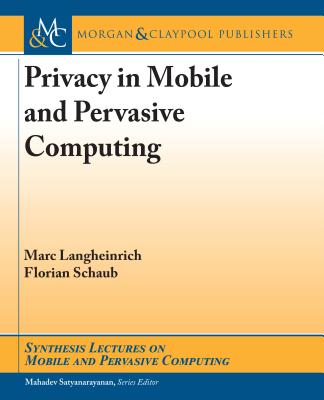Privacy in Mobile and Pervasive Computing
暫譯: 行動與普及計算中的隱私問題
Marc Langheinrich, Florian Schaub
- 出版商: Morgan & Claypool
- 出版日期: 2018-12-03
- 售價: $2,700
- 貴賓價: 9.5 折 $2,565
- 語言: 英文
- 頁數: 140
- 裝訂: Hardcover
- ISBN: 1681734583
- ISBN-13: 9781681734583
海外代購書籍(需單獨結帳)
商品描述
It is easy to imagine that a future populated with an ever-increasing number of mobile and pervasive devices that record our minute goings and doings will significantly expand the amount of information that will be collected, stored, processed, and shared about us by both corporations and governments. The vast majority of this data is likely to benefit us greatly--making our lives more convenient, efficient, and safer through custom-tailored and context-aware services that anticipate what we need, where we need it, and when we need it. But beneath all this convenience, efficiency, and safety lurks the risk of losing control and awareness of what is known about us in the many different contexts of our lives. Eventually, we may find ourselves in a situation where something we said or did will be misinterpreted and held against us, even if the activities were perfectly innocuous at the time. Even more concerning, privacy implications rarely manifest as an explicit, tangible harm. Instead, most privacy harms manifest as an absence of opportunity, which may go unnoticed even though it may substantially impact our lives.
In this Synthesis Lecture, we dissect and discuss the privacy implications of mobile and pervasive computing technology. For this purpose, we not only look at how mobile and pervasive computing technology affects our expectations of--and ability to enjoy--privacy, but also look at what constitutes "privacy" in the first place, and why we should care about maintaining it. We describe key characteristics of mobile and pervasive computing technology and how those characteristics lead to privacy implications. We discuss seven approaches that can help support end-user privacy in the design of mobile and pervasive computing technologies, and set forward six challenges that will need to be addressed by future research.
The prime target audience of this lecture are researchers and practitioners working in mobile and pervasive computing who want to better understand and account for the nuanced privacy implications of the technologies they are creating. Those new to either mobile and pervasive computing or privacy may also benefit from reading this book to gain an overview and deeper understanding of this highly interdisciplinary and dynamic field.
商品描述(中文翻譯)
很容易想像,未來將會有越來越多的行動裝置和無所不在的設備記錄我們的日常行為,這將顯著擴大企業和政府收集、儲存、處理和分享有關我們的資訊的數量。這些數據中的絕大多數可能會對我們大有裨益——透過量身定制和具上下文感知的服務,使我們的生活更加便利、高效和安全,預測我們需要什麼、在何處需要以及何時需要。但在這一切便利、高效和安全的背後,潛藏著失去對我們生活中許多不同情境下所知資訊的控制和認知的風險。最終,我們可能會發現自己處於一種情況中,某些我們所說或所做的事情會被誤解並用來指責我們,即使當時的行為完全無害。更令人擔憂的是,隱私的影響通常不會表現為明確的、有形的傷害。相反,大多數隱私傷害表現為機會的缺失,這可能會被忽視,儘管它可能會對我們的生活產生重大影響。
在這次綜合講座中,我們剖析並討論行動和無所不在的計算技術的隱私影響。為此,我們不僅探討行動和無所不在的計算技術如何影響我們對隱私的期望和享有隱私的能力,還探討什麼構成了「隱私」,以及為什麼我們應該關心維護隱私。我們描述了行動和無所不在的計算技術的關鍵特徵,以及這些特徵如何導致隱私的影響。我們討論了七種方法,可以幫助在設計行動和無所不在的計算技術時支持最終用戶的隱私,並提出六個未來研究需要解決的挑戰。
這次講座的主要目標受眾是從事行動和無所不在計算的研究人員和實務工作者,他們希望更好地理解和考量他們所創造技術的微妙隱私影響。對於剛接觸行動和無所不在計算或隱私的人來說,閱讀本書也可能有助於他們獲得這個高度跨學科和動態領域的概述和更深入的理解。






























